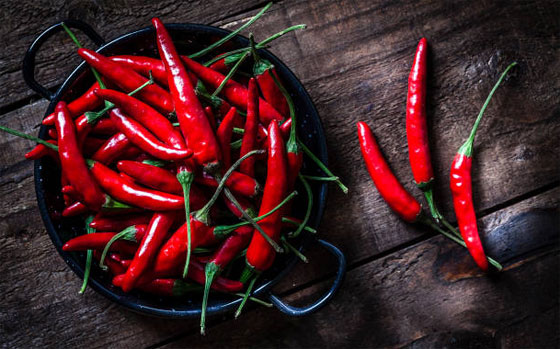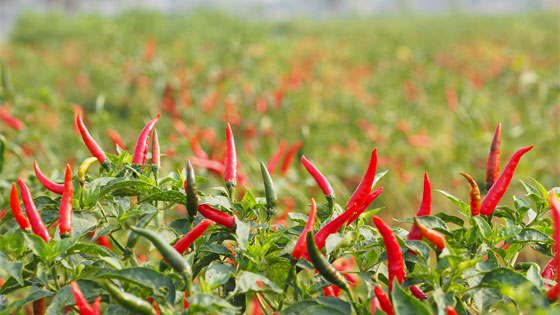This spice might extend your life
Chili peppers are a type of fruit in the nightshade family that’s associated with longer life by reducing the risk of all-cause mortality and heart- and cancer-related deaths. Scientists attribute the health benefits to capsaicin, the bioactive compound that triggers the sensation of heat in your mouth or on your skin; capsaicin is found in the seeds and inner white membrane.
Researchers from Cleveland Clinic in Ohio reviewed health records of more than 570,000 people from four large studies and found, as compared to those who rarely or never ate chili peppers, that those who ate them on a regular basis reduced their risk of death from heart-related sources by 26%, from cancer by 23% and from all-cause mortality by 25%.
This reduction in the potential risk of death is significant and could make an impact on the number of people with heart disease and cancer. An American Heart Association report released in January 2019 found 48%, or 121.5 million, adults in America had cardiovascular disease.
The 2020 statistical update showed cardiovascular disease continues to be the No. 1 cause of death, accounting for 859,125 deaths in 2017 and claiming more lives every year than chronic lower respiratory disease and all forms of cancer combined.
According to the National Cancer Institute, there will be an estimated 1.8 million people diagnosed with cancer in the U.S. and an estimated 606,520 people will die in 2020. The sheer number of people who may experience an impact on their longevity by making simple modifications to their nutritional intake is overwhelming.
While chili peppers are not the answer for everyone, it is important to note that scientific evidence continues to mount supporting the hypothesis that you can take control of your health by making consistent transformations in your lifestyle choices.
Chili peppers may extend your life
You may find chili peppers in your favorite Tex-Mex foods or Indian curry. Preliminary data presented at the American Heart Association virtual conference titled “Scientific Sessions 2020” suggest that those who regularly eat chili peppers could have a longer life.
The researchers hypothesize this is a result of the antioxidant, anti-inflammatory, anticancer and blood glucose mediating properties known to be present in chili peppers. Each of these factors may play a role in reducing the risk of cardiovascular disease or cancer.
To reach this determination, the team analyzed 4,729 studies and included four large studies with health outcomes from China, the U.S., Iran and Italy. They were surprised that past published studies demonstrated that regularly eating chili peppers could reduce the overall risk of all-cause mortality. Senior author Dr. Bo Xu commented, “It highlights that dietary factors may play an important role in overall health.” Xu, a cardiologist at Cleveland Clinic, went on to say in a press release:
“We were surprised to find that in these previously published studies, regular consumption of chili pepper was associated with an overall risk-reduction of all-cause, CVD (cardiovascular disease) and cancer mortality. The exact reasons and mechanisms that might explain our findings, though, are currently unknown.
Therefore, it is impossible to conclusively say that eating more chili pepper can prolong life and reduce deaths, especially from cardiovascular factors or cancer. More research, especially evidence from randomized controlled studies, is needed to confirm these preliminary findings.”
Xu cautioned there were several limitations, including that the four studies only had limited information on health data and confounding factors that may have influenced the results. He also noted the amounts and types of chili pepper the participants ate during the studies were also different. The researchers are continuing to analyze the data and plan to publish the literature review.
What’s the secret ingredient?
Capsaicin is the bioactive compound in chili peppers responsible for the hot and spicy kick and the likely compound researchers named as a potential explanation for the benefits they found.
Chili pepper is a fruit pod belonging to the nightshade (Solanaceae) family. Other members of the Solanaceae family include tomato, potato, eggplant, cayenne pepper and paprika. The plant is a perennial shrub that grows up to 1 meter (3.2 feet) in height and is native to Central America.
Capsaicin is concentrated in the seeds and the inner white membrane found when you cut the pod open. The plant produces capsaicin as a protection against fungal attack. Peppers with more capsaicin are spicier and hotter. While it’s colorless and odorless, it tricks your brain into perceiving heat where it touches your body.
This burning sensation is what you experience when you eat the peppers, as it is not a taste. Instead, the compound stimulates nerves that send two messages to the brain of warmth and intense stimulation. The burning sensation is a combination of these two messages.
Although the benefits of foods that contain capsaicin are plentiful, eating chili peppers is not a cure-all and some people cannot tolerate the compound or the flavor. As with many other compounds, too much of a good substance is not always a better gain. Eating too much capsaicin can trigger nausea and vomiting, diarrhea and a burning sensation in your gastrointestinal tract.
The capsaicin connection
Many of the health benefits from chili peppers come from the compound capsaicin. There are hundreds of varieties of peppers that come in different shapes, sizes, colors and degrees of hotness. How the heat is measured is based on the work of Wilbur Scoville in 1912. He developed a test to measure chili peppers’ pungency and heat that is now called “Scoville heat units”.
Different factors can affect the perception of heat and the units are used to measure anything that’s made from chili peppers. Scoville’s first tests depended on a panel of taste testers and the units were based on how dilute the pepper mixture must be before it lost the sensation of heat.
The test now uses high-performance liquid chromatography and measures the concentration of capsaicin in the product. The scale ranges from zero to 2.2 million. For example, the common bell pepper has zero Scoville heat units (SHU). Popular banana peppers range from zero to 500 SHU and Anaheim peppers can go as high as 2,500 SHU. Jalapeno peppers range from 2,500 to 8,000 SHU and serrano peppers top out at 23,000 SHU. If you’re looking for more heat, Komodo dragon peppers range from 1.4 million to 2.2 million SHU and the supreme hot chili pepper, the Carolina Reaper, is measured at 2.2 million plus SHU. When scientists measure pure capsaicin, they find it contains 16 million SHU.
Capsaicin is the active ingredient used in self-defense pepper spray. The spray burns the skin on contact and has an SHU ranging from 2 million to 5.3 million, depending upon the brand. Yet, it’s this same compound chili makers use to create their spicy concoctions that has health benefits for those who partake regularly.
In the 1980s Paul Rozin, professor of psychology at the University of Pennsylvania, studied chili and the people who ate it, describing a form of “benign masochism.” The term was used to describe how some people enjoy negative emotions when there is no real threat to their safety, like riding a roller coaster or watching a scary movie.
Later, another team of researchers from Penn State set out to discover if there were personality traits that drew some people to love spicy foods and found those who liked the burn weren’t as sensitive to the heat. “They don’t rate it as intense. And again we’re not sure if that means that biologically they’re not getting as much of a response, or if they’re desensitized, or if they are the type of person who went skydiving the day before, so the burn of capsaicin in relation to the rush of adrenalin doesn’t rate that high.
We expected the sensation-seekers to rate spicy meals higher, for example, and they did. But there was variation in their responses depending on the type of spicy meal. Some people like Asian cooking – which may include capsaicin but has other chemesthetic ingredients, too, like ginger and Wasabi – yet they don’t like chili barbecue. Why do they like one type of spicy and not another?”
Adding ginger boosts anticancer activity
Capsaicin has been studied extensively and it may surprise you how many health benefits have been associated with the compound. For instance, capsaicin may help promote long-term heart health. In one animal study involving rodents with high blood pressure, the animals experienced relief after eating food mixed with capsaicin.
The researchers suggested the compound activated the transient receptor potential vanilloid 1 (TRPV1), which contributes to vasorelaxation and lowered blood pressure. Capsaicin may also help promote healthy functioning of the digestive tract.
In one study researchers suggested capsaicin could be a gastroprotective agent in those with Helicobacter pylori mucosal damage or who use nonsteroidal anti-inflammatory drugs (NSAIDs). Capsaicin may participate in the fight against cancer by attacking cancer cell growth.
The results of one study presented at the 2019 Experimental Biology meeting in Orlando, Florida, showed capsaicin could reduce metastasis in lung adenocarcinoma, which is the majority of all non-small cell lung cancers.
While it can act on its own, in combination with 6-gingerol, a compound found in raw ginger root, evidence shows it has greater potential. In one animal study using mice prone to lung cancer, researchers found that when fed a combination of capsaicin and 6-gingerol, they had a reduced risk of lung cancer. While under observation, all the mice that received capsaicin developed lung tumors; half the mice that received 6-gingerol developed lung tumors, but only 20% of the mice given the combination developed cancer.
Capsaicin plays a role in pain relief and weight loss
Capsaicin plays a role in pain relief, in part by depleting your body’s supply of substance P. This is a chemical component of nerve cells involved in transmitting pain signals to your brain. Capsaicin also works by desensitizing sensory receptors in your skin. That’s why capsaicin is used in topical creams and patches, which deliver an intense burning sensation that ultimately relieves pain. In one case study, scientists acknowledged that capsaicin was most often analyzed for relieving postherpetic neuralgia after shingles and in HIV-associated neuropathy.
In an effort to determine if it had efficacy in other forms of neuropathic pain, capsaicin was used in a man who had persistent wound pain after a bomb explosion. He experienced an 80% reduction in symptoms after using a capsaicin patch.
The compound also may play a role in weight loss when added to your diet. In a study published in the Journal of Nutritional Science and Vitaminology, participants were given 10 grams of red pepper during a meal. After eating, the researchers monitored the participants’ energy expenditure and learned that chili peppers increased carbohydrate oxidation for as much as 150 minutes after the meal. Scientists found your body can burn an extra 50 calories per day when you consume capsaicin regularly and: “… would produce clinically significant levels of weight loss in 1-2 years. While capsaicinoids are not a magic bullet for weight loss, the evidence is that they could play a beneficial role, as part of a weight management program.”
Several studies have demonstrated that capsaicin may help reduce hunger as well. According to a study published in the European Journal of Nutrition, including capsaicin during the meal had no effect on satiety but did reduce the production of ghrelin, the hormone responsible for triggering hunger, within 15 minutes after the meal.
In another study, after 12 weeks of supplementation, participants were found to eat less and had a reduction in their waist-to-hip ratio. While not a magic bullet, chili peppers may be one weapon you can add to your arsenal of healthy food and lifestyle choices that help you take control of your health.
yogaesoteric
April 21, 2021
Also available in:
 Français
Français


